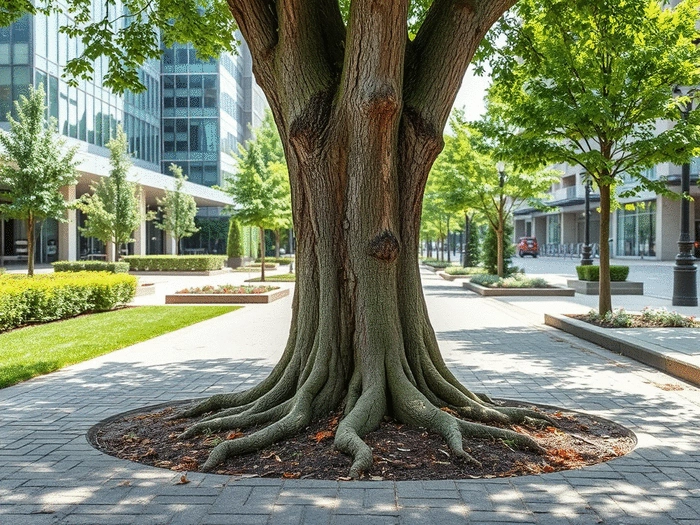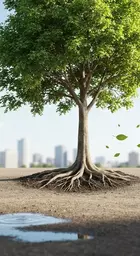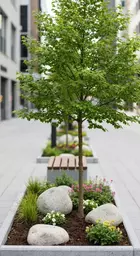Stormwater Absorption
Urban trees help absorb rainwater, significantly reducing stormwater runoff.
Impact:
- Reduction in flooding.
- Improved water quality.
Subscribe to get expert tips and the latest insights on tree care and urban greening directly to your inbox.
Posted on: 2025-07-31
By: Keira Vallejo
Urban flooding poses a significant challenge for cities, with stormwater management being essential to maintain safe and healthy neighborhoods. As we consider solutions, the role of urban trees emerges as a crucial factor in mitigating these issues. Their contributions go beyond aesthetics; they are vital in managing stormwater and enhancing urban environments. Let's delve into the key takeaways from this important topic.
Urban trees provide numerous environmental benefits that significantly contribute to stormwater management and ecosystem health.
Urban trees help absorb rainwater, significantly reducing stormwater runoff.
Impact:
Trees filter pollutants and improve urban air quality.
Impact:
Trees provide habitats for wildlife, enhancing urban biodiversity.
Impact:
Trees cool the urban environment, reducing the urban heat island effect.
Impact:
When we think about cities, we often picture tall buildings and busy streets. But did you know that urban flooding is a significant challenge many cities face today? Stormwater management is essential for keeping our neighborhoods safe and healthy. As rain falls, it can overwhelm drainage systems, leading to flooding. This is where urban trees come into play!
Urban trees play a crucial role in managing stormwater. They not only provide beauty and shade but also help absorb rainwater. However, cities grapple with challenges like impervious surfaces that prevent water absorption, leading to increased flooding risks. Understanding how to integrate trees into our urban landscapes can make a world of difference!
Stormwater is simply the water that flows over land when it rains. In urban areas, this can be problematic. Cities often lack green spaces, which means water has nowhere to go. Instead, it runs off pavement and streets, causing flooding, erosion, and water pollution.
Some common challenges cities face include:
By understanding these challenges, we can better appreciate the vital role urban trees play in managing stormwater. Trees can help mitigate these issues, making our cities safer and greener!
Now, let’s take a moment to celebrate the importance of trees in our urban environments! They offer more than just shade; they are like nature's sponges. Trees improve air quality, provide habitat for wildlife, and even enhance our mental well-being.
Some key reasons why urban trees are essential include:
As the founder of the Urban Canopy Blog, I’ve seen firsthand how trees can transform our cities. Every tree planted is a step towards a healthier urban ecosystem, benefiting both people and nature!
To truly understand how trees help manage stormwater, we need to dive into their mechanics. Trees have unique ways of interacting with rainwater that can greatly reduce flooding and improve overall urban environments.
Here's a brief recap of the key points discussed so far:
When it comes to stormwater management, not all trees are created equal! Some species excel in urban environments due to their unique characteristics that allow them to handle water effectively. Choosing the right species can significantly enhance the capacity of our city landscapes to manage stormwater.
Here are a few tree species that shine in stormwater management:
By selecting the right species, city planners can ensure that trees not only enhance the beauty of urban areas but also contribute meaningfully to stormwater management efforts!
What are the key benefits of urban trees in stormwater management?
Urban trees absorb rainwater, reduce runoff, filter pollutants, improve air quality, enhance biodiversity, and help mitigate the urban heat island effect. They also improve water quality and recharge groundwater supplies.
What are some challenges cities face regarding stormwater management?
Cities often struggle with overwhelmed drainage systems, increased water pollution from runoff, and higher risks of flooding due to impervious surfaces.
Which tree species are best for stormwater management?
Silver Maple, Red Maple, Hackberry, and Sweetgum are excellent choices due to their ability to thrive in wet conditions and effectively manage water.
How can cities maintain urban trees for optimal benefits?
Regular pruning, deep watering, mulching, and soil testing are essential for maintaining healthy urban trees that maximize stormwater management potential.
How do urban trees improve urban ecosystems?
Urban trees provide habitats for wildlife, support pollinators, improve air quality, and help reduce the urban heat island effect.
How do urban trees contribute to carbon sequestration and water quality improvement?
Trees absorb carbon dioxide from the atmosphere, filter pollutants from stormwater, and enhance water infiltration, thereby improving both air and water quality.
What considerations are there for promoting equity in urban forestry?
Community engagement, targeted planting in underserved areas, and education programs are crucial for ensuring equitable access to the benefits of urban trees.
Maintaining urban trees is essential for maximizing their stormwater management potential. Without proper care, even the best tree species may not reach their full capabilities. Here are some practical steps cities can take to keep our urban trees healthy:
With these steps, municipalities can create a thriving urban forest that maximizes benefits for stormwater management and enhances community well-being!
Urban trees do much more than manage stormwater; they play a vital role in improving local ecosystems. Trees provide habitats for various wildlife species, which can enhance biodiversity in our cities. Moreover, they help reduce the urban heat island effect, making our neighborhoods cooler and more pleasant.
The presence of trees can positively impact urban wildlife by:
So, when you see a tree on your street, remember it’s not just a pretty sight—it’s a key player in improving our urban environment!
Every tree is a carbon sponge! Through the process of photosynthesis, trees absorb carbon dioxide from the atmosphere, helping to combat climate change. Additionally, urban trees improve water quality by filtering pollutants from stormwater before it enters our waterways. If you are interested in learning more, explore how trees contribute to carbon capture.
Here’s how trees contribute to better water quality:
By investing in urban trees, we're not just beautifying our cities; we're also making a positive impact on our environment and future generations!
It’s important to remember that not every community has equal access to urban trees. Tree distribution can often reflect social and economic disparities, affecting the quality of life in those neighborhoods. Ensuring equitable access to trees is essential for fostering healthy urban environments.
Here are some considerations for promoting equity in urban forestry:
By prioritizing equity in tree care, we can create vibrant urban spaces that benefit everyone!
As we've explored, urban trees are invaluable allies in stormwater management, enhancing our cities' resilience against flooding. Their benefits extend beyond water management to improving air quality, supporting biodiversity, and promoting social equity. It's clear that trees deserve our care and attention!
Urban Canopy Blog is here to inspire you to get involved in your community's tree initiatives. Whether it’s planting a tree or advocating for green policies, every effort counts!
Let’s keep the momentum going! I encourage you to engage with local urban forestry initiatives, support sustainable practices, and share your experiences with friends and family. Every tree we nurture contributes to a greener, healthier urban environment for all. What actions will you take to support our urban canopy? Join the conversation, and let’s make a difference together!
Here is a quick recap of the important points discussed in the article:
Understanding how to care for trees is vital for their health. You can find more information on the benefits of professional tree care to maintain healthy trees.

 As urban environments evolve, the resilience of trees becomes increasingly critical in combating cli
As urban environments evolve, the resilience of trees becomes increasingly critical in combating cli
 What if the key to combating urban food insecurity lies in our own backyards? Urban fruit trees not
What if the key to combating urban food insecurity lies in our own backyards? Urban fruit trees not
 Urban environments are often described as concrete jungles, but they can also be vibrant ecosystems
Urban environments are often described as concrete jungles, but they can also be vibrant ecosystems